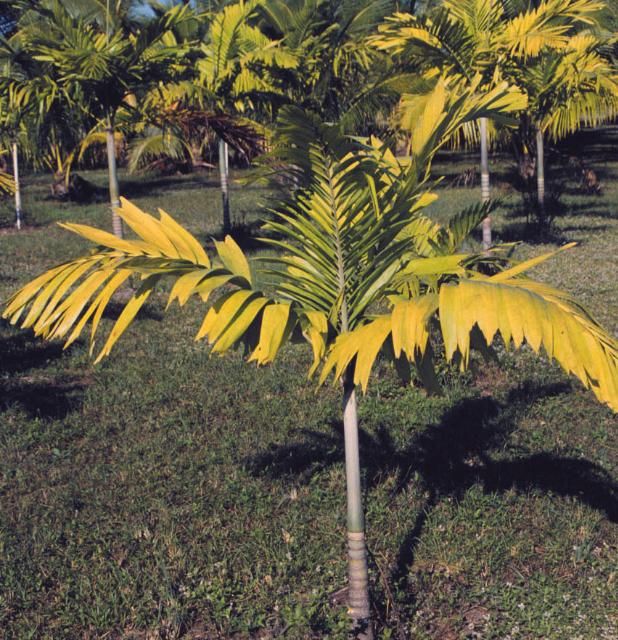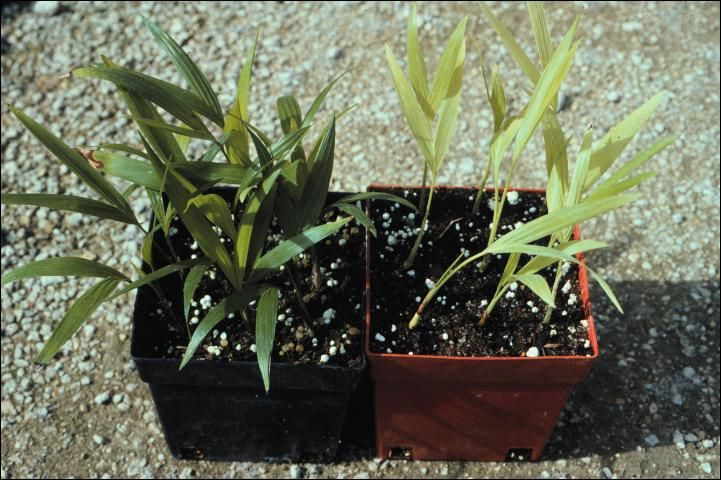Symptoms
Nitrogen deficiency begins as a uniform light-green discoloration of the oldest leaves (Figure 1). As the deficiency progresses, younger leaves will also become discolored. The golden-yellow petiole, rachis, and crownshaft color of many Dypsis lutescens (areca palms) is caused by N deficiency. When the entire crown except for the spear leaf is affected, leaves will become progressively lighter in color and may be nearly white (Figure 2). Growth virtually stops when N deficiency is severe, but the palms may linger in this state for a considerable length of time. In older palms in the landscape or field, canopy size becomes greatly reduced, very light green in color, and the trunk will taper (pencil-pointing).

Credit: T. K. Broschat, UF/IFAS

Credit: T. K. Broschat, UF/IFAS
Cause
In most mineral soils, N deficiency is typically caused by insufficient N in the soil. However, substrates used in container production of palms often contain a high percentage of organic components such as bark or peat. Since these components have a high carbon- to-nitrogen ratio, the microbes that break them down require an external source of N to do so. These microbes very effectively compete with palm roots for any available N in the soil and are the primary reason why N deficiency is such a persistent problem in container production. Water-soluble N sources are also highly leachable in most container substrates, thus greatly compounding the problem.
Occurrence
Nitrogen deficiency is by far the most important deficiency encountered in container production of palms, and all palm species are susceptible when grown in containers. However, in the field or landscape, N deficiency is common only in Ravenea rivularis and Dypsis lutescens.
Diagnostic Techniques
Nitrogen deficiency is easily diagnosed by symptoms alone, although leaf nutrient analysis can also be helpful. Nitrogen deficiency can be confused with Fe or S deficiency, although the chlorosis in those deficiencies is typically most severe on the youngest leaves. The reverse is true for N deficiency.
When sampling for leaf analysis, select four to six central leaflets from the youngest fully expanded leaf. Soil analysis is not particularly useful for diagnosing palm nutrient deficiencies, since there are no standards for soil nutrient levels for palms.
Management
Nitrogen deficiency in palms is easily prevented or treated. In container production, use of controlled-release fertilizers is highly recommended to reduce losses due to leaching. Injection of water-soluble N into irrigation water at a rate of 150 to 200 ppm is an alternative, but research has generally shown that controlled-release fertilizers result in more rapid growth with less leaching loss of N into the environment. Although N can be taken up in either ammonium or nitrate form, most palms grow better with urea or ammonium than nitrate. However, a mixture of ammonium or urea and nitrate is excellent for palms. For container production, an analysis of approximately 18N-6P2O5-12K2O is recommended.
In field production or in the landscape, N deficiency is rather uncommon and the rapid growth caused by high N fertilization can upset the nutrient balance within the palm. For that reason, fertilizers used for palms in the landscape or field nursery should have an analysis of about 8-2P2O5-12K2O+4Mg with micronutrients. Because water-soluble N is readily leached through most soils in Florida, 100% of the N should be in controlled-release form. Commonly used sources include sulfur-coated urea, urea-formaldehyde, resin-coated urea, or resin-coated ammonium salts. Fertilizers should be broadcast uniformly throughout the area under the canopy, or in landscape situations, throughout the entire landscape.
Existing N deficiencies in container or mineral soils can be corrected by using the fertilizers mentioned above. Unlike other nutrient deficiencies, N-deficient leaves will usually regain their normal green coloration when appropriately fertilized. Foliar sprays with urea or ammonium or nitrate salts can also be used to quickly re-green N-deficient palms.
Selected References
Broschat, T.K. 1984. Nutrient deficiency symptoms in five species of palms grown as foliage plants. Principes 28:6–14.
Broschat, T.K. 1995. Nitrate, phosphate, and potassium leaching from two species of container-grown plants fertilized by several methods. HortScience 30:74–77. https://doi.org/10.21273/HORTSCI.30.1.74
Bull, R.A. 1961. Studies on the deficiency symptoms of the oil palm. 2. Macronutrient deficiency symptoms in oil palm seedlings grown in sand culture. J. West African Inst. Oil Palm Res. 3:254–264.
Conover, C.A. and R.T. Poole. 1982. Influence of nitrogen source on growth and tissue nutrient content of foliage plants. (Abstr.) HortScience 17:518.